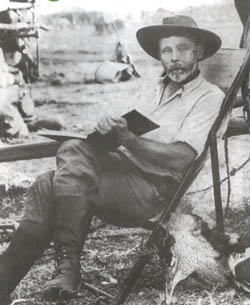Elders.
This is coolbert:
In the previous blog entry, I made reference to two doctors, men in their sixties, who have been called to active duty. Again, this was seen as a sign that the military is scraping the bottom of the barrel, using men who are of an age relatively elderly for the military.
There is precedent for men who are relatively elderly to join the military. Men that sometimes serve with distinction.
Two such men were Frederick Selous and Edward Steichen.
Frederick Selous in the late 1800's was one of the most renowned explorers and big game hunters of the era [perhaps the most renowned]. Led English expeditions from southern Africa into what was "unexplored territory". As a big game hunter brought back tons of elephant tusks for the ivory market. Entered into areas where no "white man" had ever entered before. Was mostly highly regarded by the natives. His explorations opened central Africa for subsequent colonization by the British. It is the explorations of Selous that were used as the inspiration for the book "King Solomon's Mines". When World War One began, Selous volunteered his services, even though he was in his sixties, and was given a commission as a lieutenant. While serving in COMBAT, Selous was shot in the head and killed. A tragic loss. And need not have happened. Selous could have served in a capacity that was commensurate for someone his age. But Selous was a man of honor and vigor and served where perhaps he should not have.

Edward Steichen, the distinguished American portrait and fashion photographer, volunteered for military service shortly after Pearl Harbor. He also at the time was in his sixties. Steichen HAD served in World War One, and had achieved the rank of Lieutenant Colonel. Steichen was in command of a photo center that processed reconnaissance photos taken from aircraft. Steichen felt his experience could be put to good use. Volunteering for the Navy, he WAS given a commission, with some trepidation, and did head up a unit of photographers. Men whose mission was to document by photography the war effort. Steichen's unit did some innovative photographic technique for the time. Filmed and produced the documentary film "Fighting Lady", the story of the aircraft carrier Lexington. Steichen and his men did exemplary work during the war, much of it done while filming combat action at sea. This was not an easy assignment.
Men relatively elderly can contribute to the war effort. There should not be a blanket cut-off age for service. Each case has to be looked at individually. Persons with particular skills can contribute, and mightily sometimes too. Look at each person and see if they have skills that can be used and will aid in the war effort.
[Personal note: Several years ago now there was an article in the Army Reserve magazine about a man who had been brought into the reserve forces even though he was aged and retired. It seems he had particular skills the Army needed. He could speak Hindi and several other languages of the Indian sub-continent. And this man had served in World War Two, Korea, and Vietnam as well. He WAS able to put his skills to good use. Probably doing translations of documents and such. He was brought back into the reserves with the MOS [specialty] of Laundry Specialist. Fancy that!!??]
coolbert.

0 Comments:
Post a Comment
Subscribe to Post Comments [Atom]
<< Home